Fish Farm
Introduction
The Italian name valli da pesca (fish farms)
derives from Latin vallum, which means barrier or protection. A fish
farm is a lagoon area, separated from
the open lagoon by a fixed fence nowadays made up of barriers and stakes
in which lagoon fish breeding, a kind
of extensive fish farming is practised.
This system needs big sheets of water, so that the production is sufficient
to cover the running expenses, even if the yield for land measure is low.
The documents from 11th century on witness that the fish farms belonged
to few noble families and to the Benedictine monasteries who usually granted
annual contracts of hire which could be renewed to the same lessee for
many years. In the fish farm contracts of hire that the Venetian government
used to draw up some articles were included in which the duty to care
about the building of barriers and ditches as protection of the fish farms
and in general of defensive works of the lagoon environment was assigned
to the lessee. The costs that the fish farmers had to bear for the works
and the improvements had to be refunded by the Doge's administration.
Within the fish farms the breeding of animals and hunting were practised
and both these activities represented a large supply of food that allowed
food self-sufficiency in case of need.
In the Venetian lagoon their total development
covers an area of about 92 square km which represents 1/6 of the lagoon
area: there are smaller fish farms which cover an area of just few dozen
hectares, and others which are up to 1500 hectares large (from Cavazzoni
S., "La laguna: origine ed evoluzione" and Zanetti M., "La
valle da pesca lagunare: caratteri strutturali e funzionali" in "La
laguna di Venezia").
They are situated in the most inland part of the Northern and Southern
lagoons, in the lagoon edge area (see the map salt marshes and fish farms)
in the website of the Environmental Database, in
the section images).
The fact of being separated from the lagoon
by fixed fences saves them from the ebb and flow of the tide: the setting of fixed
floodgates in the fish farms was due to the need to save the fish farm
environment from the variability of the lagoon environment, above all
as far as the pollution caused from the industrial
areas and from the chemical fertilisers employed in the countryside is
concerned.
The fish farm is a partially artificial area, created with productive
purposes, but that keeps elevated levels of natural features, contributing
to the protection of the lagoon environment. Moreover, it represents an
important place for the nest-building of a lot of birds. (from Torricelli
P., Bon M., Mizzan L., Aspetti naturalistici della laguna e laguna
come risorsa,
Parte Prima: Aspetti naturalistici della
laguna).
How a
fish farm works
The fishes in the Upper Adriatic reproduce
in the sea, in the area of the tegnue, where a great deal
of gorges protects them from the streams and from any possible predator
(See the rock outcrop card).
During their youth stage, on the other hand, they move to the inland part
of the lagoon, because there they can find
food and there are no predators. It's just the custom of the fishes to
move to the inland part that is exploited by the fish farmers who catch
the fishes during the phase called montata “swimming up” and prevent them
from going out of the fish farm barring the entrance. The only fish that
is bred in the fish farm and that doesn't reproduce in the Adriatic Sea
is the eel, whose area of reproduction is situated in the Mexican Gulf.
While the fishes go down to the sea every year during wintertime, (the
"smontada", that is to say “the swimming down to the sea”), once the eels
have entered the lagoon, they remain there,
deep in the mud of the bottom of the lagoon for a few years until they
reach their sexual maturity: then, they migrate towards the sea to reproduce.
According to some scholars, the fish farms probably existed in the lagoon
even before the foundation of the city of Venice. This practice has been
led for sure since the Middle Ages, when the embankments were mobile and
made up of reed hurdles (grisole): this technique
allowed to catch the fingerlings, while currently, due to the fixed embankments
set after the fall of the Serenissima (the Republic had always prevented
the building of fixed embankments because one of its principles was to
eliminate any obstacle to the free expansion of the tidal wave) and to the variability
in the quantity of fish that runs up naturally, the introduction of the
fingerlings must be artificially
made (from Cavazzoni S., "La laguna: origine ed evoluzione",
in "La laguna di Venezia").
Laws concerning the fish farms have been issued right since 1314, and
in 1719, in order to delimit the area subject to these ordinances and
to other laws issued by the Magistrato alle Acque, 100 boundary stones
were put to fix the lagoon boundary. The fish farms
belonged to rich families who didn't care nor were interested at all in
the breeding of fish but who mainly cared about the hunting resources
that could be found there. At the beginning the fish farms were of two
kinds:
· Seragia fish farms: the
level of water within the fish farm depends on the level of the external
water, because the fish farm is surrounded by a continuous structure made
up of stakes, grisole and poles tied up together by some
wicker;
·Embankment fish farms: the level of the internal water is made
independent from the external one by fixed ground embankments, openings
(chiaviche), floodgates
governed by the fish farmer.
The banking process of the fish farms started between the19th and 20th
century following some researches and observations performed by scholars
as Giustiniano Bullo, who created a surrounding canal and applied it to
his own fish farm called Pierimpié. Afterwards, in the middle of the 20th
century, the Italian government provided incentives for the embankment
of the fish farms.
The catching of the fingerlings from the open lagoon environment is carried
out by "pescenovellanti" (fingerlings fishermen); at the end
of the 19th century this profession was one of the most important fishing
activities for Burano’s, Caorle’s, Cortellazzo’s, Pellestrina’s and Chioggia’s
fishermen; it took place from the second half of March until the first
half of June and was very profitable (from A. Granzotto, P. Franzoi.,
A. Longo, F. Pranovi, P. Torricelli, La pesca nella laguna di Venezia: un percorso
di sostenibilità nel recupero delle tradizioni. Lo stato dell’arte).
Since ancient times the fishermen in Comacchio fish farm have started
a process of fixed banking with steady embankments of all their lagoon
area and specialized in the eel breeding.
Fish farm
structures
The main structures in the fish farm
are:
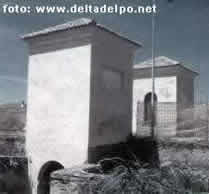 Structures
that allow the communication between the lagoon environment and the lagoon
on one hand, and between the fish farm and the rivers on the other: openings
(chiaviche), made up of
mobile floodgates supported by hand governed masonry frames, form them.
Their use allows to measure out the optimum degree of salinity for the bred fish
species and to perform the
change of water. Structures
that allow the communication between the lagoon environment and the lagoon
on one hand, and between the fish farm and the rivers on the other: openings
(chiaviche), made up of
mobile floodgates supported by hand governed masonry frames, form them.
Their use allows to measure out the optimum degree of salinity for the bred fish
species and to perform the
change of water.
There are a few structures of this kind spread along the whole fish farm,
and they are mainly used to link the different internal sheets of water,
while the main one, which connects the fish farm to the lagoon, is situated
near the "cason di pesca" (a house where the fish farmers still
nowadays live).
2. Structures employed
to carry water, made up of straight artificial canals, and from winding
natural canals.
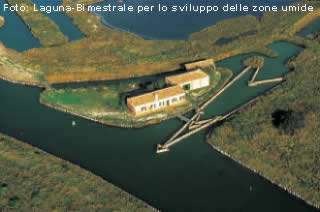
3. Structures
employed to catch the fish: they are called "lavorieri";
they belong to very large sheets of water, which are connected directly
to the main opening "chiavica". In the lavorieri
the fishes in the fish farm get trapped during a particular phase of their
breeding cycle. The lavorieri are closed
by the "cogolere", made up of
two vertical reed hurdle structures that form an acute angle.
4. Structures
for the fish farming: they are called "pescherie di sverno",
sheets of water where the fishes introduced at the beginning of the spring
that haven’t reached the right size to be put on the market are kept during
the winter.
It usually takes two or three years for
most of the fishes in the fish farm to reach the right size to be put
on the market, while the necessary length of time for the growth of the
eels is about eight years.
To protect these sheets of water from the cold wind during wintertime
tamarix hedges (Tamarix gallica)
used to be planted along their boundary. They represented an excellent
habitat for the purple herons
(Ardea purpurea) too.
Currently, synthetic nets are employed.
The pescherie di sverno are deep, so that the water on the bottom can
keep warm and the fishes can take shelter there in wintertime.
In the fish farms where there is fresh water too, a layer of fresh water
flows on the surface of the pescherie di sverno that, afterwards, during
wintertime, freezes and isolates the other underlying layers from the
cold.
5. Structures for
accommodation: the "cason di pesca" is the operation and managing
centre of the fish farm; it usually shows a 19th century style and it
is employed as accommodation for the staff who lives there for some time
during the year. The tool storehouses, the refrigerators, and the main
cavana, where the boats are kept, are located beside the cason
.
The buildings are located on rising grounds ("motta") never flooded
by the tide and built by men hoarding inert
material.
Fish farm
activities
The annual activity of the fish farms
starts at the beginning of spring.
Initially, the fingerlings are put into the
sheets of water of the fish farms. Most of the fingerlings are produced
within the structure, some other is caught in the sea ("pesca del
pesse novelo"), while just little of it reaches the fish farm running
up naturally.
At first the fingerlings are put into the seragio del pesse novelo,
a section separated from the rest of the fish farm, where the fish is
kept at least for two months so that it can acclimatize to the conditions
of the fish farm. In the seragi it is very important that a level of salinity
and of oxygenation suitable to the surviving and to the growing up of
the fingerlings are kept. Once the fishes have
reached a sufficient size, they are put into the proper fish farm through
some openings (chiaviche).
From this moment until the beginning of the autumn the fishes stay within
the chiaviche operated by the staff
of the fish farm.
Then, at the end of the autumn, the fishes are led towards the lavorieri, situated
near the sea: they are put into the fish farm through the cold water openings
(chiaviche), which makes
the fishes head towards the sea, where the temperature of the water is
higher and when, in wintertime, the reproduction takes place.
The fishes caught in the lavorieri are selected and those that have reached
a sufficient size are sent to the fish markets, while those of smaller
dimensions are led or put into the pescherie di sverno, (winter
fish pond) within which they will spend winter.
In these structures the temperature, the dissolved oxygen and the salinity
must be constantly checked not to compromise the vital conditions of the
fishes.
Sometimes in the fish farms hunting activities take place too, and in
the fish farms where this activity is practised it is possible to find
some typical structures: the botti da caccia. (from: Zanetti M., “La
valle da pesca lagunare: caratteri strutturali e funzionali” in “La
laguna di Venezia”).
Fish farm
ecosystem value
The importance of the fish farms in
the lagoon ecosystem was already clear
to the Serenissima, which in 1624 in order to save the fish farms from
public use and to preserve their functionalities, declared that they belonged
to those who performed the fishing activities.
In the fish farms the embankments show the typical vegetation of the salt marshes halophilic environments,
and the biodiversity is high, even
if it is quantitively modified compared to the original, thanks to the
richness of the trophic chains largely corresponding to the lagoon original
ones, which represent the basis for the bred fish species.
Fauna
In these areas not only do the Anatidae and other waterfowls that come
to the lagoon to spend winter from Northern Europe find the optimum environment
for the nest-building, wintering and their food supplying, but also other
birds that permanently live in the lagoon,
small mammals, and reptiles.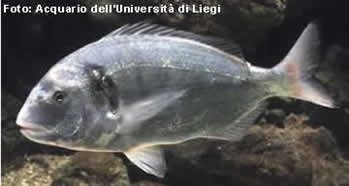
In the fish farms the eels (Anguilla anguilla), the
grey mullets (Mugil cephalus), the European
seabasses (Dicentrarchus labrax),
the gilthead seabreams (Sparus aurata) are bred.
All these species can tolerate big variations
in the salinity (euryhaline).
The fish farm offers ideal conditions to the nest-building of a lot of
birds, most of all in the beds of reed of the soft water environments.
Nest-building species as the mallard (Anas platyrhynchos), the
marsh harrier (Circus aeruginosa), the
common moorhen (Gallinula chloropus), the
common coot (Fulica atra), the snowy
plover (Charadrius alexandrinus),
the common tern (Sterna hirundo), the penduline
tit (Remiz pendulinus), the
purple heron (Ardea purpurea), the common
redshank (Tringa totanus), the black
crowded night heron (Nycticorax nictycorax)
can be found.
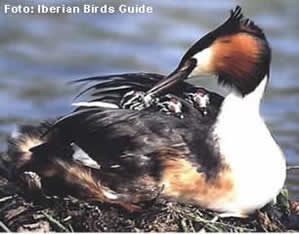
Other species only pass during wintertime
as the great crested grebe and the eared grebe (Podiceps cristatus and
P. nigricollis), the great
white (Egretta alba), and several
species of Anatidae.
Besides the fishes and the birds, small mammals as the harvest mouse (Micromys minutus), the
water shrew (Neomys fodiens), the polecat
(Mustela putorius), the
stone marten (Martes foina) the European
water vole (Arvicola terrestris), the
weasel (Mustela nivalis), the hedge
hog (Erinaceus europaeus) can
be found in the fish farms.
The dark green snake (Coluber viridiflavus),
the grass green snake, the tessellated grass snake (Natrix natrix and N. tessellata) make their
appearance too.
Flora
The fish farm vegetation rising out of
the water is typical of the salt marshes (the
Sea lavender, the Glasswort and the Puccinellia), even if with different
dominances and associations. While in the salt marshes the evolution of
the vegetation stops because of some limiting conditions as the salinity,
in the fish farms the ground is more suitable to a progress of the sequence
towards the beds of reed.
The associations that can be more usually found in the salt
marshes within the fish farms are: Sea lavander- Puccinellietum
palustris, characterized by Puccinellia festuciformis,
Limonium serotinum and Juncus maritimus (in the
less halophilic environments); and the Puccinellio –festuciformis –Arthrocnemum
fruticosi, which includes the Sarcocornia fruticosa,
on very salted and dry grounds during summertime.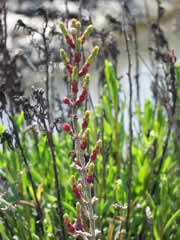
The under water vegetation is mainly made up of
two vegetation associations of phanerogamae that form a precious
food source for the anatidae: the Zostera noltii association,
which develops in the brackish areas with a good water change, and the
Ruppia maritima association
which is present in the areas of less salinity
and of more stability.
In the soft water areas there are beds of reed represented by the Phragmites australis graminaceous
plant, which can bear the presence of salt, even if in low concentration.
Where there is only soft water it is possible to find the Typha, most
of all the Typha latifolia. (From
Sburlino G., “La vegetazione delle valli da pesca della provincia
di Venezia”, in AA. VV., “Le valli da pesca del comprensorio veneziano
dal Tagliamento al Brenta”).
The importance of the fish farms lies in the fact that such environment
has substituted, in its function of ecological niche, the strip of the marshes
and of the swamps that once could be found in the lagoon
edge area. The total closure of the fish farm embankments has deprived
the lagoon of the advantages deriving from this substitution.
Among the fish farms that are still active in the Northern lagoon the
Val Dogà which, with its 1685 hectares, is the largest, Grassabò, Dragojesolo,
Cavallino, Lio Maggiore, Liona, Perini can be mentioned.
In the Southern lagoon the fish farms Serraglia,
Averto (partially employed as a WWF oasis), Contarina, Zappa, Figheri,
Pierimpié, Morosina, Millecampi. (from Rallo G., “Guida alla natura
nella laguna di Venezia- Itinerari, storia, e informazioni naturalistiche”).
A discussion is currently on about the opportunity to reopen
the fish farms to the expansion of the tide.
|



